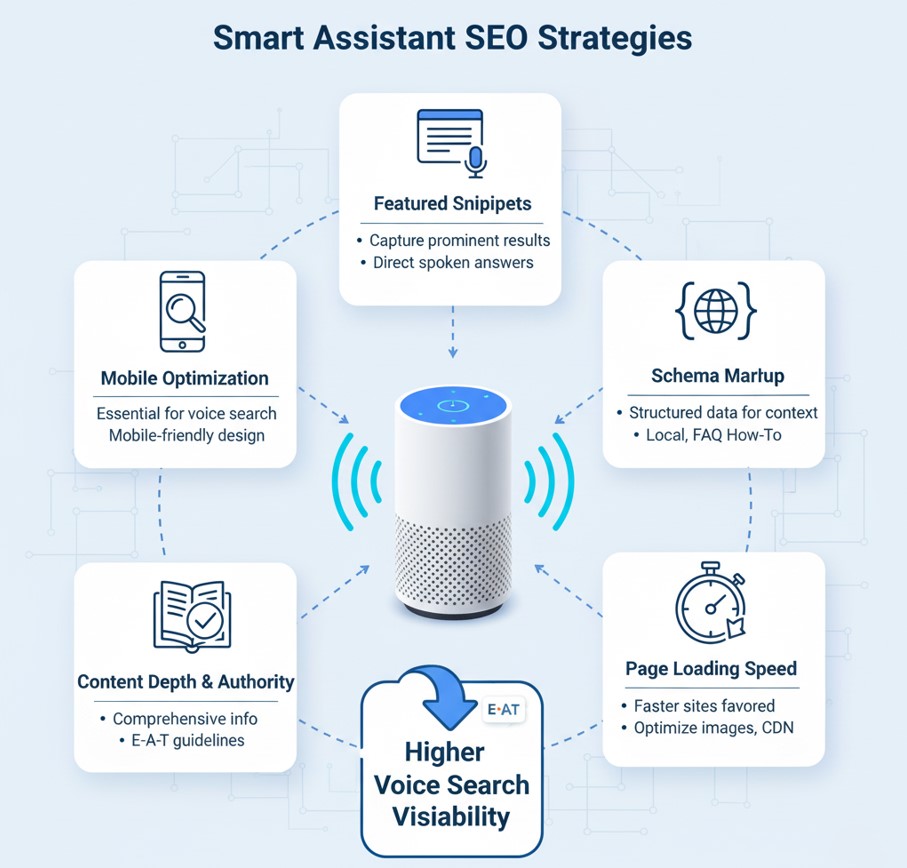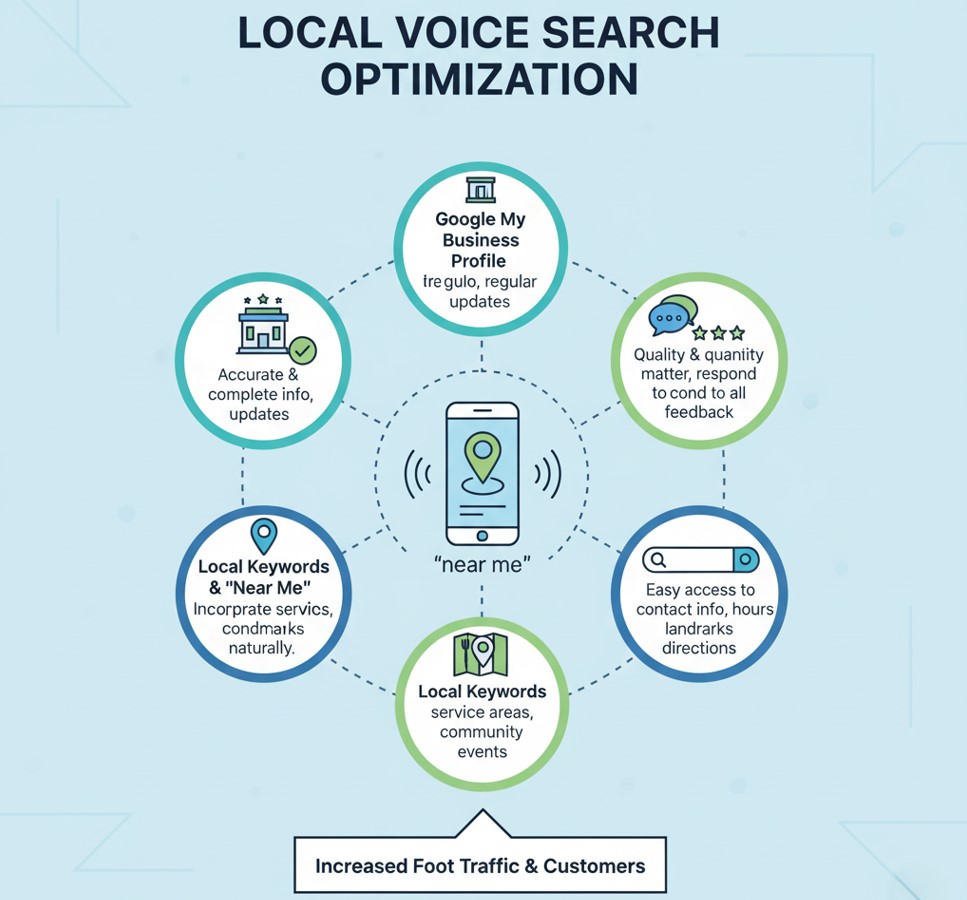
Voice search has fundamentally changed how people find information online. More than 50% of adults use voice search daily, and this number continues climbing as smart speakers become household staples. The shift from typing queries to speaking them naturally has created new opportunities—and challenges—for businesses looking to maintain their visibility in search results.
Smart assistants like Alexa, Google Assistant, and Siri don’t just respond to voice commands; they’re reshaping the entire landscape of search engine optimization. Unlike traditional text-based searches that return multiple pages of results, voice searches typically deliver a single, spoken answer. This means your SEO strategy must evolve to capture these coveted “position zero” spots.
The implications extend far beyond simple keyword optimization. Voice queries tend to be longer, more conversational, and often include question words like “how,” “what,” “where,” and “when.” People ask their devices complete questions rather than typing fragmented keywords. This behavioral shift requires a comprehensive rethinking of how we approach mobile SEM and overall digital marketing strategies.
Understanding voice search optimization isn’t just about staying current with technology trends—it’s about preparing for a future where voice interactions will likely dominate digital discovery. Businesses that adapt their SEO strategy now will have a significant advantage as voice search adoption accelerates across all demographics and device types.
The Rise of Voice Search Technology
Voice recognition technology has evolved dramatically over the past decade. Early voice assistants struggled with accents, background noise, and complex queries. Today’s smart assistants achieve accuracy rates above 95%, making them reliable tools for everyday tasks and information retrieval.
The proliferation of smart speakers has accelerated voice search adoption. Amazon’s Echo devices, Google Nest speakers, and Apple’s HomePod have made voice interaction a natural part of daily routines. People use these devices to check the weather, set timers, play music, control smart home devices, and increasingly, to search for local businesses and product information.
Mobile devices have also played a crucial role in voice search growth. Smartphone users regularly employ voice search while driving, cooking, or when their hands are occupied. The convenience of speaking rather than typing has made voice queries a preferred method for many searches, particularly those related to local services, directions, and quick fact-finding.
The accuracy improvements in natural language processing have made voice search more intuitive. Smart assistants now understand context, follow-up questions, and even implied meanings. This sophistication has increased user confidence in voice search results, leading to higher adoption rates and more complex query types.
How Voice Search Differs from Traditional Search
Voice queries exhibit distinct characteristics that set them apart from typed searches. The average voice search query contains 4.2 words compared to 2.3 words for text searches. This difference reflects how people naturally speak versus how they type—we tend to use complete sentences and questions when speaking to devices.
Question-based queries dominate voice search patterns. Users frequently begin voice searches with interrogative words, asking their devices, “What’s the best Italian restaurant near me?” rather than typing “Italian restaurant.” This conversational approach requires content creators to anticipate and answer specific questions their audience might ask.
Local intent appears in approximately 58% of voice searches. People use voice assistants to find nearby businesses, get directions, and check store hours. This local focus makes voice search optimization particularly important for businesses with physical locations or service areas.
The immediacy of voice search also influences query types. Users expect quick, actionable answers rather than multiple options to browse through. They might ask for “the closest gas station” or “tonight’s weather forecast,” seeking immediate, specific information that can be delivered verbally.
Voice search results tend to be more definitive than traditional search results. While text searches might return thousands of results for users to evaluate, voice assistants typically provide one primary answer. This creates both an opportunity for businesses that rank well and a challenge for those competing for the limited voice result slots.
Optimizing for voice search is an important part of modern Search Engine Marketing (SEM) strategies. As user behavior shifts toward more conversational queries, integrating voice search optimization with your overall SEM approach ensures better visibility across both voice and traditional search platforms.
Smart Assistant SEO Strategies

Optimizing for smart assistant searches requires a multifaceted approach that addresses both technical and content considerations. Featured snippets become particularly important since smart assistants often pull their spoken responses from these prominent search result positions. Structuring content to capture featured snippets increases the likelihood of being selected for voice search responses.
Schema markup plays a crucial role in smart assistant SEO. This structured data helps search engines understand your content’s context, making it more likely to be selected for voice responses. Local businesses should implement the local business schema, while content creators should use FAQ, recipe, or how-to schema as appropriate for their content types.
Page loading speed becomes even more critical for voice search optimization. Smart assistants favor fast-loading pages when selecting sources for voice responses. Optimizing images, minimizing code, and using content delivery networks can improve page speed and voice search visibility.
Content depth and authority signal to smart assistants that your site provides comprehensive, trustworthy information. Creating detailed, well-researched content that thoroughly addresses user questions increases the chances of being selected for voice search results. This approach aligns with Google’s E-A-T (Expertise, Authoritativeness, Trustworthiness) guidelines.
Mobile optimization remains essential since many voice searches occur on mobile devices. Ensuring your site provides excellent mobile experiences improves both traditional mobile SEM performance and voice search visibility. Mobile-friendly design, clear navigation, and readable fonts contribute to better voice search outcomes.
Voice SEO Strategy Implementation
Developing an effective voice SEO strategy begins with understanding your audience’s conversational search patterns. Research the questions your customers frequently ask, both online and offline. Tools like Answer The Public and Google’s “People also ask” sections can reveal common question formats related to your industry or products.
Create content that directly answers specific questions. Structure your content with clear headings that mirror how people ask questions. For example, if you’re a plumber, create sections titled “How much does pipe repair cost?” or “What causes low water pressure?” This question-and-answer format aligns with voice search query patterns.
Optimize for long-tail keywords that reflect natural speech patterns. Instead of focusing solely on short keywords like “plumber,” include phrases like “emergency plumber near me tonight” or “how to fix a leaking faucet.” These longer, more specific phrases match how people actually speak to their devices.
Develop location-specific content if your business serves particular geographic areas. Create pages that address common local questions and include local landmarks, neighborhoods, or regional references. This approach helps capture voice searches with local intent while building relevance for your target areas.
Monitor your voice search performance using tools that track featured snippet rankings and question-based keywords. Many SEO platforms now offer voice search tracking capabilities, allowing you to measure your visibility for spoken queries and adjust your strategy accordingly.
Local Voice Search Optimization

Local businesses have significant opportunities in voice search since location-based queries represent such a large portion of voice searches. Optimizing your Google My Business profile becomes crucial for capturing local voice search traffic. This is a key part of effective local SEO, which helps improve your visibility in both traditional and voice-driven searches. Ensure your business information is accurate, complete, and regularly updated.
Customer reviews play an increasingly important role in local voice search rankings. Smart assistants often consider review quality and quantity when selecting businesses to recommend. Encourage satisfied customers to leave detailed reviews and respond professionally to all feedback to build your local search authority.
Create content that addresses local customer questions and concerns. If you’re a restaurant, write about local food preferences, seasonal menu items, or community events. This local relevance helps smart assistants understand your connection to the geographic area and increases the likelihood of local voice search recommendations.
Optimize for “near me” searches by including location-specific keywords throughout your content. However, avoid keyword stuffing—instead, naturally incorporate references to your service areas, nearby landmarks, and local community elements into your content.
Consider the mobile context of local voice searches. People often use voice search while driving or walking, so ensure your contact information, hours, and directions are easily accessible on mobile devices. Quick access to phone numbers and addresses can convert voice search traffic into actual customers.
Content Creation for Voice Search
Voice search content should prioritize clarity and conciseness while maintaining comprehensive coverage of topics. Write in a conversational tone that matches how people naturally speak. Use contractions, shorter sentences, and everyday language rather than formal or technical jargon when possible.
Structure content with clear hierarchies using H2 and H3 headings that reflect question formats. Create FAQ sections that directly address common voice queries related to your business or industry. These sections often become sources for featured snippets and voice search responses.
Include specific details that smart assistants can easily extract and vocalize. When writing about products or services, include key information like prices, hours, locations, and specifications in easily scannable formats. Bullet points and numbered lists work particularly well for this purpose.
Develop content clusters around topics rather than isolated pages. Create comprehensive resources that cover related questions and subtopics thoroughly. This approach demonstrates topical authority and provides smart assistants with multiple relevant content pieces to draw from when formulating responses.
Update content regularly to maintain freshness and accuracy. Voice search users expect current information, and smart assistants favor recently updated content when selecting sources for responses. Regular content updates also signal to search engines that your site remains active and relevant.
Technical Optimization for Voice Search
Website speed optimization becomes even more critical for voice search success. Smart assistants favor fast-loading sites when selecting content sources, and users expect immediate responses to voice queries. Implement compression, optimize images, and minimize HTTP requests to improve loading times.
Secure your website with HTTPS encryption. Voice assistants prefer secure sites when selecting content sources, and security has become a standard ranking factor across all search types. SSL certificates are relatively inexpensive and provide both security and SEO benefits.
Implement structured data markup to help search engines understand your content context. Use appropriate schema types for your content, whether it’s local business information, FAQ content, recipes, or product details. Proper markup increases the likelihood of being selected for voice search responses.
Optimize for mobile devices since many voice searches occur on smartphones. Ensure your site loads quickly on mobile connections, displays correctly on various screen sizes, and provides easy navigation for mobile users. Mobile-first indexing makes mobile optimization essential for all search visibility.
Monitor your site’s technical health regularly using tools like Google Search Console. Address crawl errors, broken links, and other technical issues promptly to maintain your site’s ability to be indexed and selected for voice search results.
Measuring Voice Search Success
Tracking voice search performance requires a combination of traditional SEO metrics and voice-specific indicators. Monitor your featured snippet rankings since these often serve as sources for voice search responses. Tools like SEMrush and Ahrefs now provide featured snippet tracking capabilities.
Pay attention to question-based keyword rankings. Track your visibility for queries that begin with interrogative words like “how,” “what,” “where,” “when,” and “why.” These question formats closely mirror voice search patterns and indicate your content’s voice search potential.
Analyze your organic traffic patterns for longer, more conversational keyword phrases. Voice search queries tend to be longer and more specific than typed searches. Increased traffic from long-tail, question-based keywords may indicate growing voice search visibility.
Monitor local search performance metrics if your business serves specific geographic areas. Track rankings for location-based queries and monitor Google My Business insights for trends in how users find and interact with your business information.
Use Google Analytics to identify traffic sources and user behavior patterns that might indicate voice search referrals. While it’s difficult to definitively attribute traffic to voice searches, patterns in mobile traffic, local searches, and question-based queries can provide insights into voice search performance.
Voice Search FAQ
What percentage of searches are voice searches?
Approximately 20% of mobile searches are voice searches, and this percentage continues growing as smart speaker adoption increases. Some estimates suggest voice searches could represent up to 50% of all searches within the next few years.
Do voice searches and text searches return the same results?
Not always. Voice search results tend to favor featured snippets, local results, and content that can be easily spoken aloud. Text searches return multiple results for users to browse, while voice searches typically provide one primary answer.
How long should content be for voice search optimization?
Voice search answers typically range from 29 to 35 words. However, the source content should be comprehensive and detailed to demonstrate authority. The key is having concise, extractable answers within longer, thorough content pieces.
Can voice search help local businesses?
Yes, significantly. About 58% of voice searches have local intent, making voice search optimization particularly valuable for local businesses. Optimizing Google My Business profiles and creating location-specific content can capture substantial local voice search traffic.
What role do customer reviews play in voice search?
Customer reviews influence local voice search rankings and can provide content that smart assistants reference when answering questions about businesses. Positive reviews with specific details help establish credibility and local relevance.
How important is website speed for voice search?
Website speed is crucial for voice search optimization. Smart assistants favor fast-loading sites when selecting content sources, and voice search users expect immediate responses. Page speed has become an increasingly important ranking factor across all search types.
Should I create separate content for voice search?
Rather than creating entirely separate content, optimize existing content for voice search by adding FAQ sections, using conversational language, and structuring information in easily extractable formats. This approach serves both traditional and voice search users effectively.
Preparing for the Voice-First Future
Voice search represents more than a technological trend—it signals a fundamental shift toward more natural, conversational interactions with digital information. Businesses that adapt their SEO strategies now will be better positioned as voice search adoption continues expanding across demographics and device types.
The key to voice search success lies in understanding user intent and creating content that directly addresses the questions your audience asks. Focus on providing clear, authoritative answers while maintaining the comprehensive coverage that builds topical authority. This approach serves both current voice search users and positions your content for future voice search developments.
Technical optimization remains important, but content quality and relevance ultimately determine voice search success. Invest in creating valuable, question-answering content that serves your audience’s needs while implementing the technical foundations that make your content discoverable by smart assistants.
Start implementing voice search optimization strategies gradually, focusing first on your most important pages and highest-value keywords. Monitor your results, adjust your approach based on performance data, and continue expanding your voice search optimization efforts as you see positive results. The future of search is increasingly conversational, and preparing for this shift will benefit your overall digital marketing strategy.
Learn more about: How to Combine SEM and SEO for Maximum Visibility


Leave a Reply